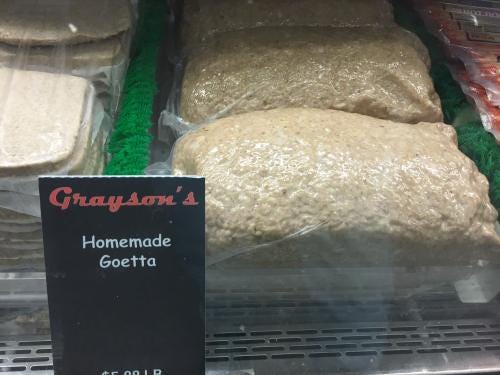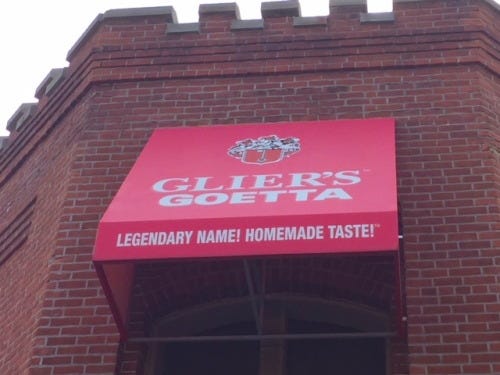Cincinnati has a deep association with the production of food. In 1902 Kroger launched their first grocery here, and was the first market to bake their own bread. The city is the birthplace of Crisco–the first hydrogenated vegetable oil, developed from cotton seed in 1911 to replace lard. In 1964, the Kenner Toy Company introduced the Easy Bake Oven to inspire a whole generation of future chefs in the Baby Boom era. Here, too, the art of butchery—mostly of hogs and cattle–was practiced with great pride in the cold weather months of the 19th and early 20th centuries before refrigeration changed the world.
Prepared by Newport native Gary Schultz, goetta tops a casserole of hashed potatoes, eggs, and cheese.
This gritty, post-industrial city was established on the banks of the Ohio and Licking Rivers, a stone’s throw from Kentucky, where goetta—a mealy breakfast sidemeat made from pork parts (including heart and skin), beef, pinhead oats, onions, and secret spices–is still manufactured and bravely consumed.
Goetta’s local power as a nostalgia food has even led to the development of a healthier dopplegänger. Vegan goetta, which I found for sale in Cincinnati’s meat-dominated Findlay Market, is made with pinhead oats, tofu, quinoa, and flax seeds. Glier’s Goetta plant, in sight of Cincinnati’s skyscrapers but located in Covington, Kentucky, produces more than a million pounds of this slow-cooked concoction each year and retails it in the form of six-pound sliceable slabs and mini-slabs, tubes, burger-sized patties, and “bun links.” Glier’s has also added a version made from turkey and another that features smoked bacon in the mix. At Findlay Market, a goetta egg roll the size of a burrito was displayed under glass along with the standard slab pictured here.
Homemade at the Findlay Market in downtown Cincinnati
Though the nickname “Porkopolis” was not meant as a compliment, Cincinnati earned the moniker in the 1830s because neighboring farmers from the countryside drove their pigs down the streets here all day long toward the Packing House District where they were slaughtered, salted, and stored in barrels, then shipped to points west and south, down the Ohio to the Mississippi River as far as New Orleans. It was a bloody and smelly business mostly carried out by immigrant Germans and Irish, much in the same way that Hispanic immigrants labor in hazardous poultry processing plants in North Carolina today.
The historic neighborhood of Newport on the Kentucky side of the Ohio River was called Bratwurst Row until the Irish moved in, and it was renamed Sausage Row. Now the western shoreline–once notorious for mob-run gambling houses, strip bars, and nightclubs long before Vegas became Vegas–has been transformed into a family friendly destination with greenway bike and walking trails, entertainment and educational venues, chain restaurants, and retail shops.
In Newport I sampled jägerschnitzel at the very first U.S. franchise of Munich’s 400-year-old Hofbrau Haus, famous for its liter-sized mugs of heavy glass or crockery filled with either Ale, Dunkel (dark) or Heifeweizen (wheat-based) beer. This bierhaus was opened in 2003, one of the first steps in the revitalization of Newport. Now the Munich-based mother ship has established additional restaurants in other historic German neighborhoods in Pittsburgh, Cleveland, Columbus, Chicago, and most recently in St. Petersburg, Florida, and in that catch-all, Las Vegas. The schnitzel (pork) was good, the mushroom gravy even better, and the sides of sweet and sour German potato salad and fried cabbage were strong complements.
But before this hefty meal, my native hosts, Roberta and Gary Schultz, and I had to sample the local beer cheese I’d heard so much about, served here with soft, hot, ballpark-sized pretzels.
To my surprise, after dipping a length of pretzel into the small warmed crock of beer cheese, it tasted more like a Swiss fondue–gruyere flavored with white wine—rather than cheddar made spreadable with the addition of beer. Perhaps the taste was to be expected from a recipe created under Bavarian influences instead of the originators of beer cheese some 100 miles to the south in Clark County, Kentucky.
And thus began my research down the rabbit hole of Kentucky beer cheese, a deeply cherished edible memory for many residents of the Bluegrass State, and an elusive and evolving recipe that continues to be the object of much debate and rivalry here.
Kentucky beer cheese is not to be confused with the similarly named Bierkäse, aka Weisslacker—a soft, white, cow’s milk cheese with a strong stench and a mild taste that did originate in Germany. Rather, Kentucky’s beer cheese is a spread first served in the 1940s in Clark County at a restaurant/marina run by Johnny Allman, a former boxer, police officer, and hotel manager who eventually opened his first restaurant on the “wet” side of the Kentucky River near Boonesborough. (Beer could not be served in the county on the opposite shore.) Also known for his catfish and fried banana peppers, Allman reportedly got the recipe for the beer cheese and fried peppers from a cousin who worked as a chef in Arizona.
Allman’s last restaurant in a series in the same general location along the river burned down in 1978. According to Jeffrey Scott Holland writing in Kentucky Monthly, a number of entrepreneurs have since attempted to imitate his original recipe. Then, nearly a decade ago, Johnny Allman’s grandson Ian began offering a grocery store tub that holds fast to his forebear’s recipe, which reportedly requires aged Wisconsin cheddar mashed up with a drizzle of beer until achieving “a richly textured coarseness” with the addition of one or all of these ingredients—garlic, dry mustard, horseradish, onion, and/or cayenne pepper.
The relative proportions required among these ingredients are a subject of ongoing debate in the Bluegrass State. More recent recipes suggest the addition or substitution of Worcestershire, Sriracha or chipotle chili powder.
Hall’s On The River Restaurant, at one time owned by Allman and supposedly lost in a card game, is located upstream from the site of Allman’s last establishment that burned down. Hall’s also lays claim to the origin of beer cheese, by geography if not by precise recipe. They now offer an upscale dining experience along with their own statewide branded label called Hall’s Original Snappy Beer Cheese, all the while careful to give the Allman family their historic due. Apparently, Queen Elizabeth took some Original Snappy home with her after a visit to Lexington some years back–another claim to fame.
At the Beer Cheese Festival held in Clark County each June, contestants vie for bragging rights to the perfect mimicry of Johnny Allman’s original, which was, Holland writes, served in the restaurant “ice cold in white paper cups,” accompanied by packages of wrapped saltines and crudités, such as celery and radish. (There is even some ambiguity in whether said saltines were of the square variety or the sweeter, rectangular Captain’s Wafers.)
The most salient detail, however, is that Johnny Allman reportedly used Pabst Blue Ribbon as the beverage of choice in his spread. Others suggest Kentucky Ale should be the premium ingredient, though Budweiser has also stepped forward to contribute its own recipe on line. Allowing the beer to reach room temperature and go a bit flat before mixing seems to be the only universal requirement.
As I discovered on my 48-hour pilgrimage in the region, the craft beer industry is alive and well in Cincinnati, while Ohio is ranked fourth in the nation in the number of craft barrels produced per year. In Kentucky the growth in craft beer making is also steady, so it’s probably safe to assume that future beer cheese making in either state will reach beyond its roots, what with so many evolving tastes and potential techniques in the mixing of beer and cheese. Still, there are those who pine for the original, says Jeffrey Scott Holland, perhaps in the same way that native Cincinnatians still account for 99 percent of the consumption of goetta.







